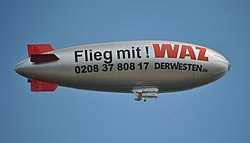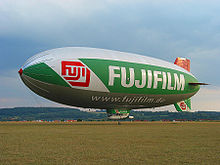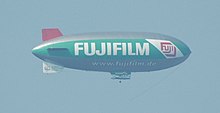WDL airship company
| WDL Luftschiffgesellschaft mbH | |
|---|---|
| legal form | GmbH |
| founding | 1972 |
| Seat | Mülheim an der Ruhr |
| management | Barbara Majerus, Frank Peylo (Managing Director) |
| Number of employees | 30th |
| Branch | Aerial advertising, tourist flights |
| Website | http://www.wdl-worldwide.com/ |
The company WDL Luftschiffgesellschaft mbH is a subsidiary of the WDL Group, which designs and operates impact airships . It was founded in 1972. The main location of the company is the Essen / Mülheim airfield , from where the company operates aerial advertising and offers tourist flights.
Since the company was founded, twelve airships have been constructed to date, which have been used at home and abroad by external and their own advertising companies.
history
History and milestones of flight operations
The hydrogen-filled impact airship D-LEMO, in use for the Braun company , was the first airship with which WDL was able to gain experience in the late summer of 1969. This gave rise to the wish of the WDL owner, the businessman Theodor Wüllenkemper from Mülheim / Ruhr, to build a larger helium-filled airship.
The first WDL 1 airship took off on its maiden flight on August 12, 1972 . This airship was initially used as an advertising medium for the Wicküler brewery in Wuppertal under the name "The Flying Musketeer". At the same time a second airship has already been manufactured for sale to Japan. Despite a severe storm in November 1972 that destroyed the airship hangar and two ships inside, the owner rebuilt everything.
In 1976, WDL 1 was used to transport freight to West Africa. They were part of the development aid projects at the time. A critical article in the Spiegel in 1989 saw that DM 5 million in tax money was "put in the sand of the steppe".
The successor type WDL 1B has been manufactured since 1988.
In the early 1990s, the WDL created a concept study within which an airship with a capacity of 16 passengers was determined. However, the study never got beyond the project stage.
In 1993 the WDL received a US license to fly for the first time.
According to the manufacturer's website, four airships were in service around the world in early 2005. WDL has a large tent hall at Essen-Mülheim airfield, which serves as winter quarters for two airships. This hall is 90 m long, 46 m wide and 26 m high. In addition, WDL has two hangars.
At the end of 2006, Fujifilm , one of WDL's main customers, gave up its advertising on airships (including on all other airships internationally). The decision was justified with a new direction of the company, as well as a different use of the advertising budget. The last sightseeing flights with Fujifilm imprint were made from July 1st to 30th, 2006 from Essen-Mülheim Airport. The airship has had the WAZ media group's imprint since 2009 and sightseeing flights can be undertaken again.
After the airship was almost completely destroyed in a storm in June 2014, it was rebuilt. The new envelope from Ballonbau Wörner in Augsburg with a helium volume of 6700 m² was delivered on May 26, 2015. It is 59.75 m long and 19.30 m high.
Accidents
- At the end of May 1994 there was an accident in Gießen in which two people died. When a WDL-1B airship approached a regional glider airfield, the ship was accelerated excessively by a gust of wind and threatened to collide with the ground, whereupon the pilot abandoned the attempt to land and took off. The ten-person ground crew had already tried to capture the airship at this point. Eight people had already seized the land ropes attached to the airship. The head of the ground crew and another employee, however, were at the height of the airship gondola. After the airship pilot took off, the eight people let go of the ropes. For inexplicable reasons, however, the two other people clung to the gondola and were pulled up over 100 m with the airship and then fell to their death. During the second attempt to land, the airship pilot was able to land the airship safely.
Similar accidents have already happened with other airships, e.g. B. USS Akron or LZ 120 (see also: List of accidents with airships ). - During a storm on June 9, 2014 , the WDL Blimp was almost completely destroyed. The airship was attached to the mast during the hurricane, but then overturned due to excessive wind.
WDL-1
| WDL-1 | |
|---|---|
| Type: | Impact airship for tourism and advertising purposes |
| Design country: | |
| Manufacturer: |
WDL Luftschiffgesellschaft mbH |
| First flight: |
1972 |
| Production time: |
1972-1988 |
Technical specifications
| Parameter | Data |
|---|---|
| General characteristics | |
| Construction year: | 1972 |
| Length: | 58 m |
| Diameter / max. Width: | 14.3 m |
| Height: | 18.4 m |
| Volume: | 6,429 m³ |
| Drive units: | 2 × Continental 6-cylinder engines with 154 kW each |
| Max. Altitude: | 1,800 m |
| Top speed: | 90 km / h |
| Cruising speed: | 80 km / h |
| Boost: | 6,300 kg |
| Empty weight: | 4,800 kg |
| free payload: | 241 kg |
| gondola | |
| Length: | 7.6 m |
| Width: | 1.6 m |
| Height: | 2 m |
| Capacity: | 8 passengers |
WDL-1B
| WDL-1B | |
|---|---|

|
|
| Type: | Impact airship for tourism and advertising purposes |
| Design country: | |
| Manufacturer: |
WDL Luftschiffgesellschaft mbH |
| First flight: |
1988 |
| Production time: |
ongoing |
History and background
The airships can use a large lamp field (33 × 8 m with 9000 lamps as pixels ) to present neon signs and animations in the sky at night .
Technical specifications
| Parameter | Data |
|---|---|
| Construction year: | 1988 |
| System price: | € 5 million |
| Crew: | 1 pilot |
| capacity | 7 passenger seats |
| Necessary ground staff: | 18 people |
| Length: | 60 m |
| Diameter / max. Width: | 16.4 m |
| Height: | 19.3 m |
| Envelope volume: | 7,200 m³ |
| Ballonet volume and proportion: | 1,975 m³ (27%) - three: front, middle, back |
| Shell material and properties: | multi-layer and double-sided coated fabric ;
Strength of 4,000 daN / m; Lifespan around 20 years |
| Drive units: | 2 × Continental motors with 154 kW each |
| Max. Altitude: | 1,800 m |
| Top speed: | 105 km / h |
| Cruising speed: | 65 km / h |
| Range: | 1,680 km |
| Mission duration | 22 h |
| Max. Payload / payload: | 1,300 kg (general)
1,900 kg (including lamp field) |
useful information
- In 1998, when airship construction seemed to be experiencing a renaissance with the companies Zeppelin Luftschifftechnik and Cargolifter AG , the WDL carried out a detailed study on the limits and possibilities of airship construction. In particular, it was criticized that airships with a length of over 60 m would be very difficult to obtain a permit to fly, would only land on a few areas and would also have significant problems with cross winds. The WDL company accordingly assessed the chances of success for the construction of a Zeppelin NT and the Cargolifter CL160 to be very low.
- During a mission in Japan, in which a WDL airship was exposed to snowfall at the landing mast, the company and the ground crew used an unconventional method: the snow was washed off the airships with warm water.
- Arnold Beier, long-time managing director of WDL Luftschiff Gesellschaft, also commented in 1999 on the chances of success for Cargolifter AG . Although he was not averse to the basic idea, he pointed out two serious problem areas at an early stage. On the one hand, he made it clear that the planned Cargolifter CL160 airship could have immense problems in snowfall. On the other hand, Beier showed that gas management and the “printing” of an airship filled with 450,000 m³ of helium could cause immense problems; especially if the radiation intensity of the sun and thus the ambient temperature were to change, it is conceivable that the lift forces would change rapidly. In an interview with the newspaper Die Zeit , he commented on these problems as follows: If the sun only heats the shell of the Cargolifter by one degree, the expansion of the helium gives an additional lift of 1.8 tons. And that happens especially when the airship is stationary and not cooled by the airstream. Regarding the snow problem, he noted: Another problem arises when it snows. Just imagine what would have happened to such an airship during the snowfall in mid-February. Tremendous burdens come together.
Web links
- Homepage of the WDL
- Hang out from the airship Theo Airship Theo, youtube video (2:36), April 27, 2017
literature
- JK Bock, B. Knauer: Lighter than air: transport and carrier systems . Verlag Frankenschwelle, Hildburghausen 2003, ISBN 3-86180-139-6 .
Individual evidence
- ↑ wdl-worldwide.com , accessed January 15, 2020.
- ↑ a b Deike Frey: Mülheim airship flies again after being destroyed by Ela. WAZ.de, January 13, 2015.
- ↑ Westdeutsche Luftwerbung Theodor Wullenkemper GmbH & Co. KG ( Memento of the original dated November 7, 2017 in the Internet Archive ) Info: The archive link was inserted automatically and has not yet been checked. Please check the original and archive link according to the instructions and then remove this notice. de.kompass.com, accessed November 6, 2017.
- ↑ Bock / Knauer: Lighter than air: Transport and carrier systems, p. 370.
- ↑ Information board in the Zeppelin Museum Friedrichshafen 08/2009
- ↑ Airships: A little heliumkrank spiegel.de, No. 44, October 30, 1989, accessed November 6, 2017.
- ↑ Bonner General-Anzeiger (September 12, 1991): There are currently 30 Zeppelin pilots worldwide. Only two airships are circling for advertising purposes.
- ↑ HandelsBlatt (January 13, 1993): WDL Luftschiffgesellschaft received American approval. The silver “promotional cigar” needs a team of 20 to operate.
- ↑ Bock / Knauer: Lighter than air: Transport and carrier systems, p. 338.
- ↑ a b c d http://www.wdl-worldwide.de/index.php/das-luftschiff Homepage of WDL accessed on January 6, 2017
- ↑ Saarbrücker Zeitung (May 24, 1994): Landing unsuccessful: Zeppelin tore two people with it - dead. Experienced landing helpers fell 100 meters down.
- ↑ WAZ.de: Storm tears up the airship “Blimp” at Essen / Mülheim Airport, last accessed on January 6, 2016
- ↑ Jürgen K. Bock, Berthold Knauer: Lighter than air: transport and carrier systems. Verlag Frankenschwelle, Hildburghausen 2003, ISBN 3-86180-139-6 , p. 31; 200; 213.
- ↑ Jürgen K. Bock, Berthold Knauer: Lighter than air: transport and carrier systems. Verlag Frankenschwelle, Hildburghausen 2003, ISBN 3-86180-139-6 , p. 31; 204; 470.
- ↑ Focus Magazin (August 3, 1998): ZEPPELINE: Castles in the Air.
- ↑ a b Die Zeit (March 11, 1999): castles in the air full of helium. The zeppelin is experiencing a renaissance: as a heavy truck and vehicle for gentle tourism.



